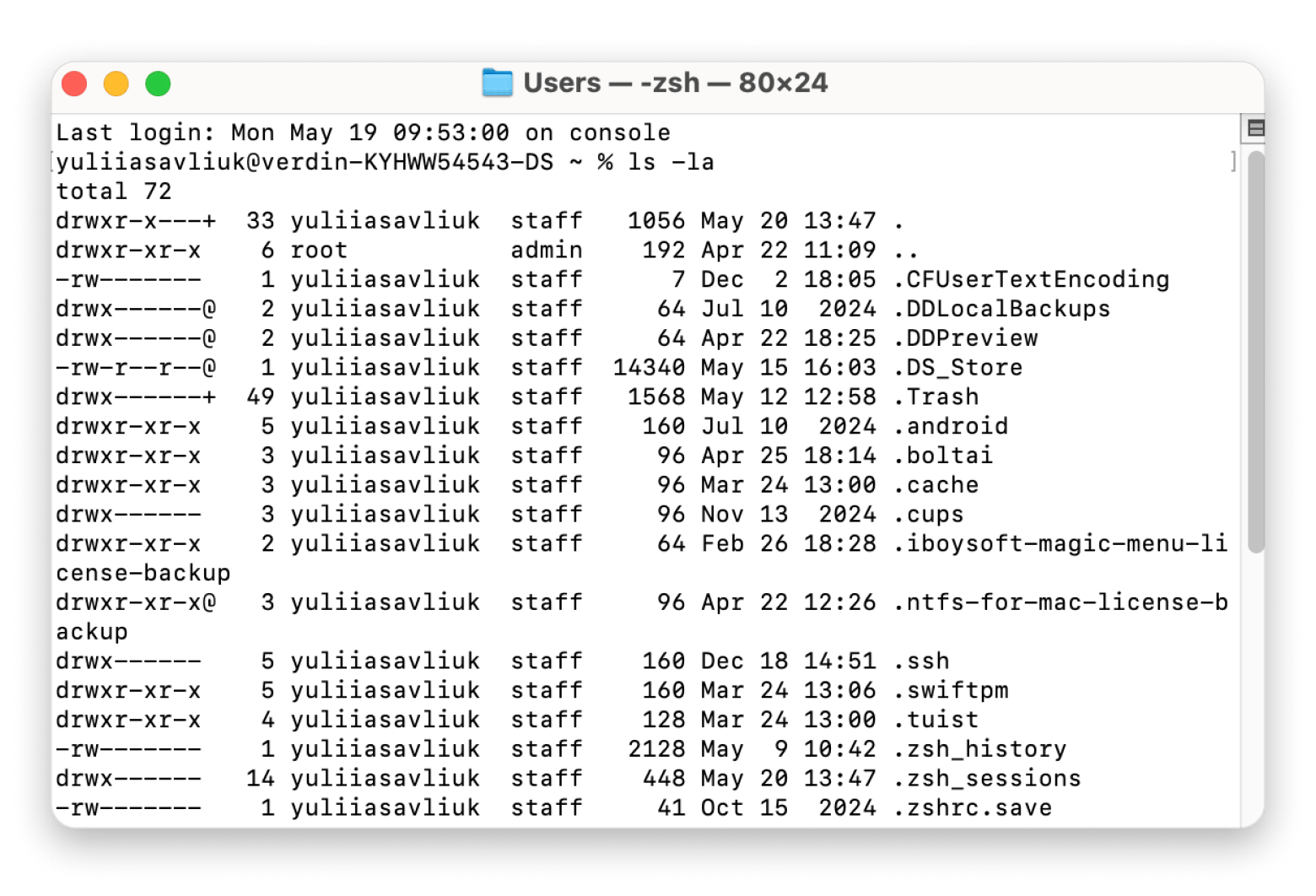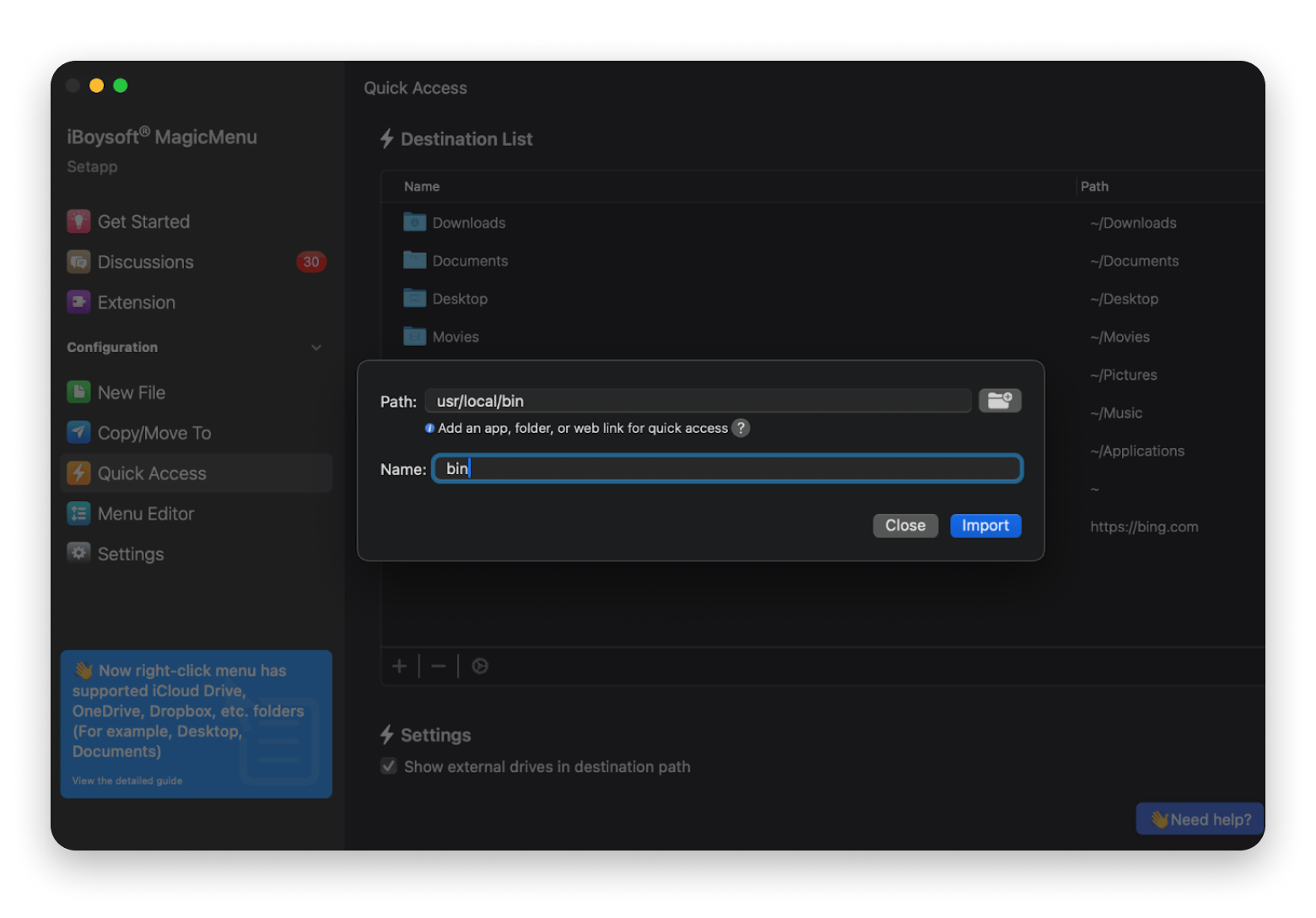How to access /usr/local/bin on Mac: I use these quick methods
Never seen any system files on your Mac? Even though macOS takes up tens of gigabytes on your hard drive, there are no traces of it anywhere.
macOS prefers to hide critical data from users as a safeguard against them accidentally deleting or tampering with files that can break your Mac. But, you may need to access those hidden files and folders, like usr, local, and bin. How can you do this?
I’ll explain what the bin folder and Mac usr folder are, how to open bin files on Mac, and the safest way to manage hidden files.
But first, here’s a quick overview to help you figure out what you’re trying to do and the easiest way to get it done:
What are you trying to do? | What to do? |
Access the hidden /usr/local/bin folder | Press Shift + Command + . (period) in Finder to reveal hidden files. |
Navigate directly to the folder | Use Go > Go to Folder in Finder and type /usr/local/bin. |
Explore the folder using Terminal | Run commands like cd /usr/local/bin and ls -la in Terminal |
Manage files more efficiently | Use Commander One for dual-pane navigation and better file control. |
Add /usr/local/bin to the right-click menu | Set it up with iBoysoft MagicMenu. |
How to access /usr/local/bin in Finder
The general problem with usr, local, bin, and other similar folders is that they're not visible. The first thing you can do is to make all invisible files visible. To do that, go to Finder and then press Shift + Command + the period key (.).
You’ll see some new files in light gray color appear with a dot before their name:

So, where's /usr/local/bin? To locate it:
- Open Finder.
- Click Go > Computer in the menu bar.
- Double-click Macintosh HD.
- Select usr > local > bin or follow any other path you need.

Read also:
- How to show Library folder on Mac
- How to create a file on Mac
- Delete recent searches
- Show hidden files on Mac
How to find a bin folder in Terminal
To open Terminal:
- Go to Finder > Applications > Utilities > Terminal.
- A simple command to list all files and folders in the current directory is ls -la followed by Return. You’ll immediately see all the hidden files in your directory.
- To go up a level in the folder structure, type cd .. and press Return. To go down a level, type cd [folder name] and press Return.

Check out 11 Terminal alternatives for Mac to use in 2025.
Open /usr/local/bin by right click
This folder’s hidden by default, so getting to it isn’t exactly straightforward. Personally, I found using the Go option in Finder every time a bit of a pain. What helped me was setting up a right-click shortcut with a third-party app called iBoysoft MagicMenu, which saves time and just makes things easier.
Here’s how it works:
- Install and open iBoysoft MagicMenu.
- Click Quick Access from the left-hand sidebar.
- Click the “+” button at the bottom of the list of directories.
- Enter /usr/local/bin into the path field or use the Add Folder (Browse) button on the right to add this folder, then name it.
- Click Import. The folder will now appear in your list of Quick Access directories.

The first time I selected it from the Quick Access menu by right-clicking in Finder, I got a prompt asking for permission to access the folder. Just click Allow when that shows up, and you’ll be able to open it from the Quick Access menu without any issues after that.
Adding scripts to /usr/local/bin in macOS Sonoma
If you want to manually handle scripts (e.g., myscript.sh) within the usr/local/bin folder on macOS Sonoma, here are some Terminal commands you can use for different actions:
- Moving the script to /usr/local/bin, type: sudo mv /path/to/your/myscript.sh /usr/local/bin.
- Making the script executable and setting permissions, type: sudo chmod +x /usr/local/bin/myscript.sh.
- Testing the script, type: myscript.sh.
As shown above, the /path/to/your/ represents the path to your script.
Managing /usr/local/bin with Homebrew
If you don’t like the detail-oriented nature of handling Mac executables manually, you can rely on a tool like Homebrew to do the heavy lifting. It automatically installs a wide range of tools properly, which makes it easy to rely on them when working via Terminal without issues.
I like that it helps keep your tools up-to-date. This is particularly important if you’re a developer relying on specific dependencies or a professional using rapidly evolving tools. Homebrew can help you set up tools like wget and ffmpeg and keep them fine-tuned.
The process is a bit lengthy, so here's the full guide on how to install Homebrew on your Mac.
What is a bin folder?
A bin folder (short for binary) is a directory that stores executable files. These are the actual command files your Mac uses to run apps and perform tasks. It's where the system or user-installed programs keep the commands needed to function. Advanced users might want to access the bin folder to change various app configuration files or license numbers, for example.
By looking at the name, you might assume that the bin folder is the same as Trash, but it couldn’t be further from the truth.
Also, check out how to password protect a folder on Mac.
What is a usr folder on Mac?
The usr folder is a hidden system directory on macOS. Contrary to what many believe, "usr" doesn’t mean “user” but “user-related.” It contains important read-only data like libraries, documentation, binaries, and other software components that help your Mac's apps run smoothly. These files are essential for system operations but are not meant to be accessed or modified by users.
Why is usr not visible on Mac?
macOS hides the usr folder to protect critical system files from accidental changes that could damage the system. It's the same reason why plumbing and wiring are hidden in your house. They're not pretty, and something can go very wrong if you modify them in a way they are not supposed to be modified. Advanced users can still access these folders using Finder, Terminal, or third-party tools.
What is a /usr/local/bin folder on Mac?
The /usr/local/bin folder stores executable files installed locally by the administrator and is usually used for apps shared by multiple users. These files aren’t part of the operating system’s core but won’t be overwritten during macOS updates.
Final thoughts on how to access the usr local bin folder on Mac
When I first tried to access the /usr/local/bin folder, I had no idea where to start. It felt like the folder didn’t even exist. Turns out, macOS hides these system-level folders by default to protect them, but once I learned the trick, they finally showed up. I also found it super helpful to use Terminal for navigating around with commands like cd and ls -la, especially when Finder felt too limited.
Over time, I realized that relying on Finder alone just wasn’t cutting it for the way I work. That’s when I started using Commander One and iBoysoft MagicMenu. Commander One made it way easier to move files around thanks to its dual-pane view. And with iBoysoft, I added quick shortcuts to the right-click menu, so I could jump straight into folders like /usr/local/bin without typing the path every time.
The best part? I didn’t have to buy these apps separately. Both of them are available through Setapp, which gives you access to over 260 Mac and iOS apps with one subscription. I started with the 7-day free trial just to see if it was worth it, and honestly, it was. If you're managing files all the time like I am, it makes life a whole lot easier.
FAQs
What is the purpose of the usr/local/bin directory?
The purpose of the usr/local/bin directory is to store executable files that aren’t part of the base operating system but have been installed locally. This is where tools like command-line utilities, scripts, or software installed via Homebrew typically live.
How can I access the usr folder on a Mac?
To access the usr folder, open Finder, click Go > Go to Folder, and type /usr/. Press Return. Keep in mind this folder is hidden, so you may need to press Shift + Command + . (period) in Finder, first to reveal hidden folders.
What can be found inside the usr/bin folder?
Inside the usr/bin folder, you can find executable commands for your Mac apps. It’s where many of the core commands you use in Terminal, like cp, mv, and ls, are stored.
How do I navigate to usr/local/bin on a Mac?
To navigate to usr/local/bin on a Mac, open Finder, click the Go option in the menu bar, and type the path /usr/local/bin. Alternatively, use a third-party app like iBoysoft MagicMenu to add this location to the Quick Access option in the right-click menu.






